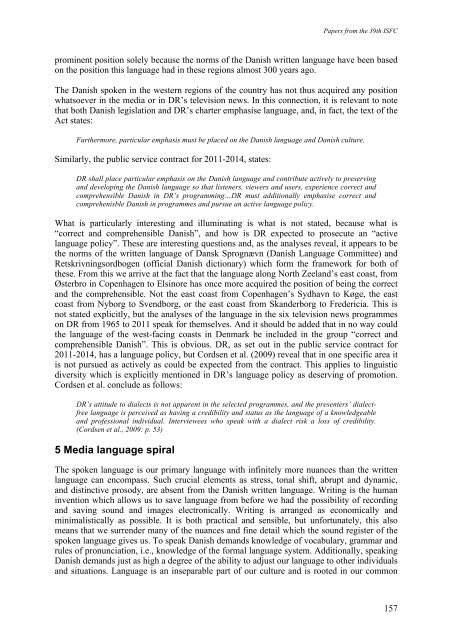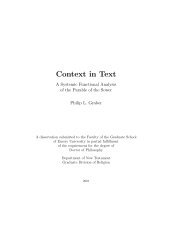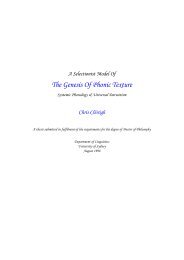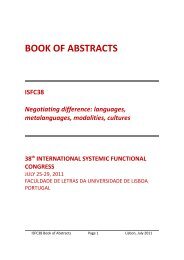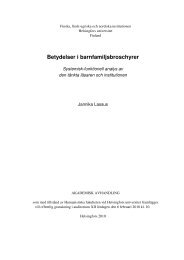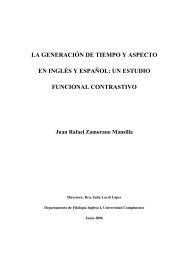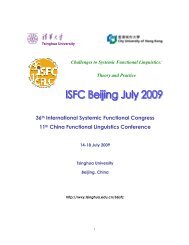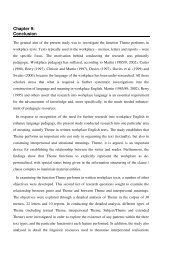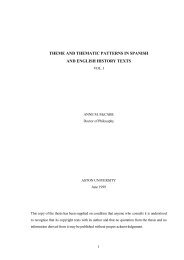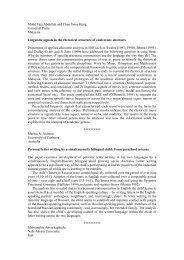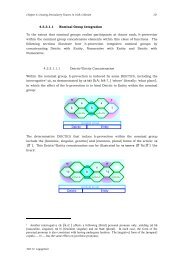the ISFC39 Proceedings - International Systemic-Functional ...
the ISFC39 Proceedings - International Systemic-Functional ...
the ISFC39 Proceedings - International Systemic-Functional ...
Create successful ePaper yourself
Turn your PDF publications into a flip-book with our unique Google optimized e-Paper software.
Papers from <strong>the</strong> 39th ISFCprominent position solely because <strong>the</strong> norms of <strong>the</strong> Danish written language have been basedon <strong>the</strong> position this language had in <strong>the</strong>se regions almost 300 years ago.The Danish spoken in <strong>the</strong> western regions of <strong>the</strong> country has not thus acquired any positionwhatsoever in <strong>the</strong> media or in DR’s television news. In this connection, it is relevant to notethat both Danish legislation and DR’s charter emphasise language, and, in fact, <strong>the</strong> text of <strong>the</strong>Act states:Fur<strong>the</strong>rmore, particular emphasis must be placed on <strong>the</strong> Danish language and Danish culture.Similarly, <strong>the</strong> public service contract for 2011-2014, states:DR shall place particular emphasis on <strong>the</strong> Danish language and contribute actively to preservingand developing <strong>the</strong> Danish language so that listeners, viewers and users, experience correct andcomprehensible Danish in DR’s programming…DR must additionally emphasise correct andcomprehenisble Danish in programmes and pursue an active language policy.What is particularly interesting and illuminating is what is not stated, because what is“correct and comprehensible Danish”, and how is DR expected to prosecute an “activelanguage policy”. These are interesting questions and, as <strong>the</strong> analyses reveal, it appears to be<strong>the</strong> norms of <strong>the</strong> written language of Dansk Sprognævn (Danish Language Committee) andRetskrivningsordbogen (official Danish dictionary) which form <strong>the</strong> framework for both of<strong>the</strong>se. From this we arrive at <strong>the</strong> fact that <strong>the</strong> language along North Zeeland’s east coast, fromØsterbro in Copenhagen to Elsinore has once more acquired <strong>the</strong> position of being <strong>the</strong> correctand <strong>the</strong> comprehensible. Not <strong>the</strong> east coast from Copenhagen’s Sydhavn to Køge, <strong>the</strong> eastcoast from Nyborg to Svendborg, or <strong>the</strong> east coast from Skanderborg to Fredericia. This isnot stated explicitly, but <strong>the</strong> analyses of <strong>the</strong> language in <strong>the</strong> six television news programmeson DR from 1965 to 2011 speak for <strong>the</strong>mselves. And it should be added that in no way could<strong>the</strong> language of <strong>the</strong> west-facing coasts in Denmark be included in <strong>the</strong> group “correct andcomprehensible Danish”. This is obvious. DR, as set out in <strong>the</strong> public service contract for2011-2014, has a language policy, but Cordsen et al. (2009) reveal that in one specific area itis not pursued as actively as could be expected from <strong>the</strong> contract. This applies to linguisticdiversity which is explicitly mentioned in DR’s language policy as deserving of promotion.Cordsen et al. conclude as follows:DR’s attitude to dialects is not apparent in <strong>the</strong> selected programmes, and <strong>the</strong> presenters’ dialectfreelanguage is perceived as having a credibility and status as <strong>the</strong> language of a knowledgeableand professional individual. Interviewees who speak with a dialect risk a loss of credibility.(Cordsen et al., 2009: p. 53)5 Media language spiralThe spoken language is our primary language with infinitely more nuances than <strong>the</strong> writtenlanguage can encompass. Such crucial elements as stress, tonal shift, abrupt and dynamic,and distinctive prosody, are absent from <strong>the</strong> Danish written language. Writing is <strong>the</strong> humaninvention which allows us to save language from before we had <strong>the</strong> possibility of recordingand saving sound and images electronically. Writing is arranged as economically andminimalistically as possible. It is both practical and sensible, but unfortunately, this alsomeans that we surrender many of <strong>the</strong> nuances and fine detail which <strong>the</strong> sound register of <strong>the</strong>spoken language gives us. To speak Danish demands knowledge of vocabulary, grammar andrules of pronunciation, i.e., knowledge of <strong>the</strong> formal language system. Additionally, speakingDanish demands just as high a degree of <strong>the</strong> ability to adjust our language to o<strong>the</strong>r individualsand situations. Language is an inseparable part of our culture and is rooted in our common157


